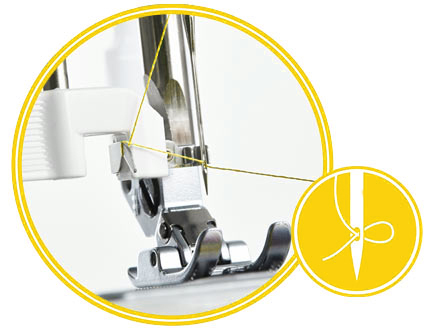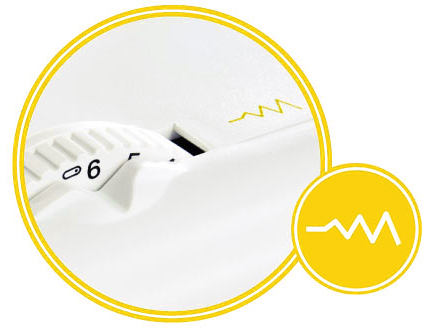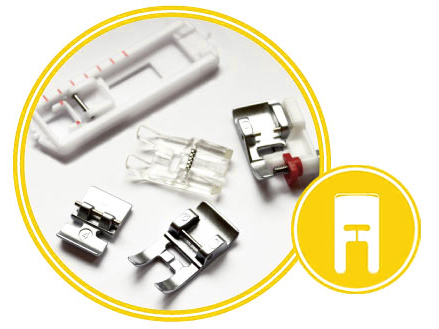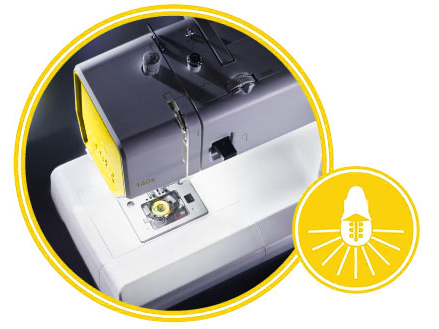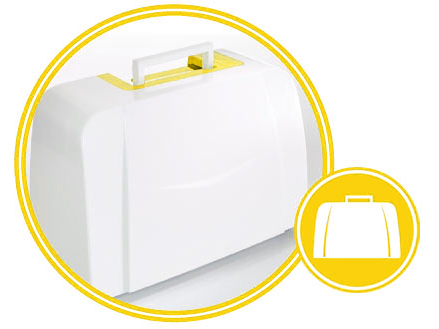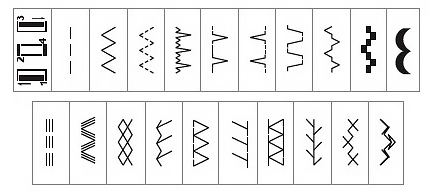Посмотреть инструкция для Pfaff Smarter 130S бесплатно. Руководство относится к категории швейные машины, 3 человек(а) дали ему среднюю оценку 8.6. Руководство доступно на следующих языках: английский. У вас есть вопрос о Pfaff Smarter 130S или вам нужна помощь? Задайте свой вопрос здесь
Не можете найти ответ на свой вопрос в руководстве? Вы можете найти ответ на свой вопрос ниже, в разделе часто задаваемых вопросов о Pfaff Smarter 130S.
Какой размер иглы лучше всего использовать?
Какой срок службы у швейной иглы?
Что может повредить иглу при шитье?
Инструкция Pfaff Smarter 130S доступно в русский?
Не нашли свой вопрос? Задайте свой вопрос здесь
- Manuals
- Brands
- Pfaff Manuals
- Sewing Machine
- Smarter
- Owner’s manual
-
Contents
-
Table of Contents
-
Troubleshooting
-
Bookmarks
Quick Links
Owner’s
Manual
160s
150s
140s
130s
SMARTER BY PFAFF
™
– inspired and developed by the premier PFAFF
sewing machine brand
®
Related Manuals for Pfaff Smarter
Summary of Contents for Pfaff Smarter
-
Page 1
Owner’s Manual 160s 150s 140s 130s SMARTER BY PFAFF ™ – inspired and developed by the premier PFAFF sewing machine brand ®… -
Page 2: Important Safety Instructions
This household sewing machine is designed to comply with IEC/ EN 60335-2-28 and UL1594. IMPORTANT SAFETY INSTRUCTIONS When using an electrical appliance, basic safety precautions should always be followed, including the following: Read all instructions before using this household sewing machine. Keep the instructions at a suitable place close to the machine.
-
Page 3
• Do not use bent needles. needle causing it to break. • Wear safety glasses. in the needle area, such as threading needle, changing needle, threading bobbin, or changing presser foot, etc. • Never drop or insert any object into any opening. •… -
Page 4
FOR EUROPE ONLY: This appliance can be used by children aged from 8 years and above and persons with reduced physical, sensory or mental capabilities or lack of experience and knowledge if they have been given supervision or instruction concerning use of the appliance in a safe way and understand the hazards involved. -
Page 5: Table Of Contents
TABLE OF CONTENTS INTRODUCTION ……… 6 ……….21 Machine Overview ……….6 ……….22 …………6 Adjustable Needle Position ……22 Top Parts …………7 ……….22 …………7 Accessories …………7 SEWING ……….23 Included Accessories not in Picture ..7 ….23 Presser Feet ………..8 ……23 ……9 ……….23 ….10 ……24 ……24…
-
Page 6: Introduction
INTRODUCTION Machine Overview Front Side 1. Threading slots 12. Needle bar 2. Thread cutter 3. LED light 4. Reverse lever 14. Bobbin cover 5. Free arm 15. Lower thread guide 6. Accessory tray 16. Needle screw 17. Presser foot lift 18.
-
Page 7: Top Parts
Top Parts 21. Presser foot pressure dial 22. Thread guides 24. Hole for auxiliary spool pin 25. Bobbin winder spindle 26. Take-up lever 27. Thread tension discs 28. Bobbin winder tension disc 29. Thread tension dial Rear Side 31. Main switch, connectors for power cord and foot control 32.
-
Page 8: Presser Feet
Presser Feet Standard Presser Foot 0 This foot is used mainly for straight stitching and zigzag stitching with a stitch length longer than 1.0 mm. Clearview Foot 1 When sewing decorative stitches or short zigzag stitches and other utility stitches with less than 1.0mm stitch length, use this smoothly over the stitches.
-
Page 9
Stitch Overview – 150s/160s Stitch Name Description 1-step Buttonhole For all straight stitching and topstitching Triple zigzag stitch For stitching on elastic band, darning tears and patches Blindhem stitch For invisible hem attachment Elastic blindhem For invisible hem attachment and simultaneous stitch * serging, also for stretch fabrics Decor stitch… -
Page 10
Stitch Overview – 130s/140s Stitch Name Description 4-step Buttonhole For all straight stitching and topstitching Triple zigzag stitch* For stitching on elastic band, darning tears and patches Elastic blindhem For invisible hem attachment and simultaneous stitch * serging, also for stretch fabrics Blindhem stitch For invisible hem attachment Greek stitch… -
Page 11: Preparations
2. Remove all outer packing material and the plastic bag. Note: Your SMARTER BY PFAFF™ 130s/140s/ 150s/160s sewing machine is adjusted to provide the best stitch result at normal room temperature. Ex- treme hot and cold temperatures can affect the sewn result.
-
Page 12: Free Arm
Pack away after Sewing Note: After switching off, residual power may still remain in the machine. This may cause the light to stay on for a few seconds while the power is consumed. This is normal behavior for an energy 2.
-
Page 13: Spool Pins
Spool Pins Your machine has two spool pins, a main spool pin and an auxiliary spool pin. The spool pins are designed for all types of thread. The main spool pin is used in a Narrow thread spool the horizontal position for normal threads and the vertical position for large spools or specialty threads.
-
Page 14: Threading The Machine
Threading the Machine Make sure that the presser foot is raised and the needle is in its highest position. 5. Thread the needle.
-
Page 15: Needle Threader
Needle Threader The integrated needle threader allows you The needle must be in its highest position to use the built-in needle threader. Turn the handwheel until the notch on the wheel is lowering the presser foot. 1. Use the handle (B) to pull the needle threader all the way down.
-
Page 16: Threading For Twin Needle
Threading for Twin Needle Replace the sewing needle with a twin needle. Make sure that the presser foot is raised and the needle is in its highest position. 1. Place the thread spool on the spool pin and fit the appropriately sized spool cap.
-
Page 17: Bobbin Winding
Bobbin Winding spool cap tightly against the spool. front to the back. Pull the thread clockwise around the inside to the outside. 4. Place the bobbin on the bobbin spindle. 5. Push the bobbin spindle to the right to activate the bobbin winding. Press the foot control to wind the bobbin.
-
Page 18: Presser Foot Pressure
Presser Foot Pressure The presser foot pressure has been pre-set to not need to adjust the presser foot pressure. very light or heavy fabric, adjusting the pres- sure can improve the result. For very light fabrics, loosen the pressure by turning the dial counterclockwise.
-
Page 19: Needles
Needles The sewing machine needle plays an important role recommend needles of system 130/705H. The needle package included with your machine contains needles Universal Needle (A) Universal needles have a slightly rounded point and come in a variety of sizes. For general sewing in a vari- ety of fabric types and weights.
-
Page 20: Lowering Feed Dogs
Lowering Feed Dogs You can lower the feed dogs by moving the switch at the back of the free arm to the wish to raise the feed dogs. Note: The feed dogs will not raise immediately when the lever is switched. Turn the handwheel one full turn or start sewing to re-engage the feed dogs.
-
Page 21: Stitch Selection
Stitch Selection desired stitch. The selected stitch is the one The stitches printed in white on the stitch Use non-stretch stitches when sewing woven fabrics, leather or vinyl and stretch Note: Always raise the needle above the fabric and presser foot before you turn the stitch selc- tion dial.
-
Page 22: Adjustable Needle Position
Stitch Width sired stitch width. The higher the number, the wider the stitch width. The stitch width can be varied wheel correspond to the stitch width in Note: Before you turn the stitch width dial, raise the needle to its highest position, other- wise it may bend or break.
-
Page 23: Sewing
SEWING stitch scribed, a chart shows the recommended set- chart to the right. Start to Sew – Straight Stitch A. Recommended stitch B. Stitch length in mm Raise the presser foot and position the fab- C. Stitch width in mm ric under it, next to a seam allowance guide line on the needle plate.
-
Page 24: Reinforced Straight Stitch
Reinforced Straight Stitch stitch This stitch is stronger than regular straight stitch, due to the fact that it is a triple and elastic stitch. The reinforced straight stitch can be used for heavy stretch fabrics, for Set for reinforced straight stitch crotch seams which are subject to consider- able strain and for topstitching heavy fabrics.
-
Page 25
Overlock Stitch stitch The open overlock stitch sews the seam and overcast the edge all at one time, perfect for stretch fabrics. This stitch is more elas- tic than normal seams, very durable and Set for overlock stitch Tip: When sewing, guide the fabric edge along the metal pin of the foot. -
Page 26: Blindhem
Blindhem stitch The blindhem stitch is used to make invisible hems on skirts, trousers and home decorating. 1. Finish the edge of the hem. Set for blindhem stitch 2. Fold and press the hem allowance to the wrong side. 3. Fold the hem back on itself so approxi- extends beyond the fold.
-
Page 27: Darning With The
Sewing on Patches or Appliqués stitch To cover large holes it is necessary to sew a new piece of fabric onto the damaged area. Baste the new piece of fabric onto the dam- aged area on the right side of the fabric. Set for three-step zigzag stitch the three-step zigzag stitch.
-
Page 28
Sewing on Buttons stitch 1. Remove the presser foot and lower the Set for button sewing 2. Mark the fabric where the button is to be located. Place the fabric and button under the ankle with the holes in the button lined up with the swing of the needle. -
Page 29
Standard Buttonhole stitch (model 150s/160s) The fabric should be interfaced and/or stabi- lized where buttonholes are to be sewn. Set for buttonhole 1. Mark the start position and buttonhole Push the button holder open by pushing Push the button holder forward until button will determine the length of the buttonhole. -
Page 30
Standard Buttonhole stitch (model 130s/140s) The fabric should be interfaced and/or stabi- lized where buttonholes are to be sewn. Set for buttonhole Prepare the Buttonhole Measure diameter and thickness of the but- tain correct buttonhole length. Mark the start position and buttonhole length on the fabric Note: Before starting to sew any buttonhole, al- ways push the the buttonhole foot fully back. -
Page 31: Stretch Fabrics
Use seam ripper and cut the buttonhole open from both ends towards the middle. The density of the buttonhole is adjusted Note: Density varies according to the fabric. Al- Carefully cut your buttonhole ways test sew a buttonhole on the fabric you are open with a seam ripper.
-
Page 32: Sewing Zippers
Sewing Zippers stitch the right or the left of the needle, making it 1.5-3 easy to sew both sides of the zipper. To sew the left side of the zipper, attach the Set for zipper To sew the right side of zipper, attach the Center Zipper Right presser foot Left presser foot…
-
Page 33: Maintenance
MAINTENANCE Cleaning the Machine To keep your sewing machine operating well, Wipe the exterior surface of your machine with a soft cloth to remove any dust or lint built up. Cleaning the Bobbin Area Note: Raise the needle, lower the feed dogs and turn off the machine.
-
Page 34: Troubleshooting
TROUBLESHOOTING ® your machine. For further information please contact your local authorized PFAFF dealer. General Problems The Seam has Uneven Stitches Fabric does not move? Is the thread tension correct? Make sure that the feed dogs are not lowered. Check needle thread tension and the threading.
-
Page 35: Intellectual Property
Bobbin Thread Breaks Did you insert the bobbin properly? Check the bobbin thread. Is the stitch plate hole damaged? Change the stitch plate. Is the bobbin area clean? Clean lint from bobbin area. Is the bobbin wound correctly? Wind a new bobbin. design.
-
Page 36
4710092-26A English © 2014 KSIN Luxembourg II, S.ar.l. All rights reserved. Printed in Germany on environmentally-friendly paper…
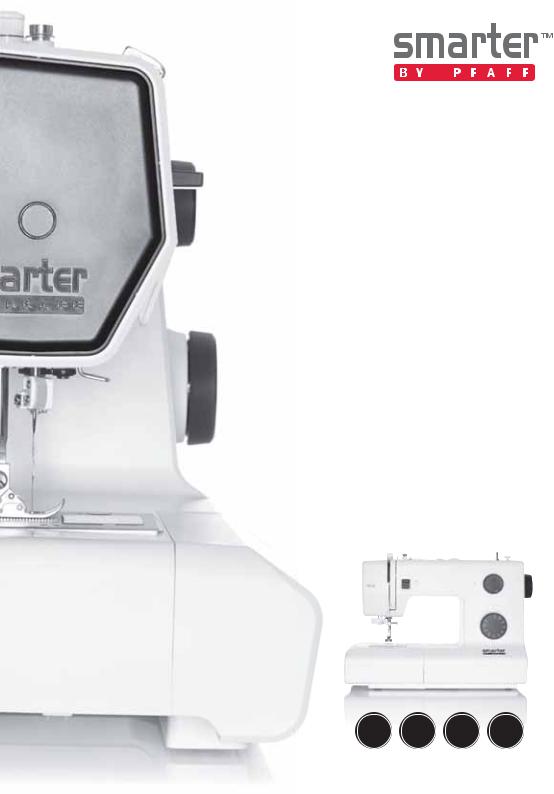
Mode d’emploi
160s 150s 140s 130s
SMARTER BY PFAFF™ – des machines inspirées et développées par la prestigieuse marque de couture PFAFF®
Cette machine à coudre à usage domestique est conçue pour répondre aux normes IEC/EN 60335-2-28 et UL1594.
CONSIGNES DE SÉCURITÉ IMPORTANTES
Lors de l’utilisation d’un appareil électrique, les précautions de sécurité essentielles doivent toujours être respectées, y compris les suivantes :
Lisez attentivement toutes les instructions avant d’utiliser cette machine à coudre à usage domestique. Conservez les instructions dans un lieu approprié près de la machine. Veillez à les transmettre avec la machine si celle-ci est donnée à une autre personne.
DANGER – POUR REDUIRE LE RISQUE DE DECHARGE ELECTRIQUE :
•Vous ne devez jamais laisser une machine à coudre sans surveillance lorsqu’elle est branchée. Débranchez toujours cette machine à coudre de la prise immédiatement après l’avoir utilisée et avant
GH OD QHWWRHU G·HQOHYHU OHV FDSRWV GH OXEULÀHU RX ORUVTXH YRXV faites n’importe quels autres réglages mentionnés dans le manuel d’instruction.
AVERTISSEMENT – POUR REDUIRE LE RISQUE DE BRULURES, D’INCENDIE, DE DECHARGE ELECTRIQUE OU DE BLESSURES CORPORELLES :
•Ne laissez personne jouer avec la machine. Il est fortement recommandé de redoubler d’attention lorsque cette machine à coudre est utilisée par ou près d’enfants.
•N’utilisez cette machine à coudre que pour son usage prévu, comme décrit dans ce manuel. N’utilisez que les accessoires recommandés par le fabricant, conformément aux indications fournies dans ce manuel.
•Ne faites jamais fonctionner cette machine à coudre si la prise ou le cordon sont endommagés, si elle ne fonctionne pas correctement ou si elle est tombée par terre ou a été endommagée ou plongée dans l’eau. Retournez la machine au distributeur ou au centre technique le plus proche de chez vous pour toute révision, réparation ou réglage mécanique ou électrique.
•Ne faites jamais fonctionner la machine à coudre si une ou plu-
2
sieurs ouvertures de ventilation sont bouchées. Évitez toute présence de peluche, poussières, chutes de tissus dans la ventilation ou dans la pédale de commande.
•N’approchez pas les doigts des parties mobiles, en particulier au niveau de la zone située autour de l’aiguille de la machine.
•Utilisez toujours la plaque à aiguille appropriée. L’utilisation d’une plaque inappropriée risquerait de briser les aiguilles.
•N’utilisez jamais d’aiguilles tordues.
•Ne tirez pas sur le tissu et ne le poussez pas pendant la couture. Vous éviterez ainsi de faire dévier l’aiguille puis de la casser.
•Portez des lunettes de sécurité.
•Éteignez la machine (interrupteur sur « 0 ») lors des réglages au
QLYHDX GH O·DLJXLOOH SDU H[HPSOH HQÀODJH GH O·DLJXLOOH FKDQJHment d’aiguille, bobinage de la canette, changement de pied presseur, etc.
•Ne faites jamais tomber, ni glisser un objet dans les ouvertures.
•N’utilisez pas la machine à l’extérieur.
•N’utilisez pas votre machine à proximité de bombes aérosols ou de vaporisateurs, ou lorsque de l’oxygène est administré.
•Pour débrancher, commencez toujours par éteindre votre machine (interrupteur sur « 0 »), puis retirez la prise du secteur.
•Ne débranchez pas la machine en tirant sur le cordon. Pour débrancher, saisissez la prise et non le cordon.
•La pédale est utilisée pour faire fonctionner la machine. Évitez de placer d’autres objets sur la pédale.
•N’utilisez pas la machine si elle est mouillée.
•Si le voyant LED est endommagé ou cassé, il doit être remplacé par le fabricant ou son agent de service, ou toute autre personne
TXDOLÀpH DÀQ G·pYLWHU OHV ULVTXHV
•Si le cordon de la pédale est endommagé, il doit être remplacé par le fabricant ou son agent de service, ou toute autre personne
TXDOLÀpH DÀQ G·pYLWHU OHV ULVTXHV
•Cette machine est équipée d’une double isolation. N’utilisez que des pièces détachées d’origine. Voir les instructions relatives à l’entretien des appareils à double isolation.
CONSERVEZ CES INSTRUCTIONS
3
POUR L’EUROPE UNIQUEMENT :
Cet appareil peut être utilisé par des enfants de plus de 8 ans ainsi que des personnes ayant des capacités physiques, sensorielles ou mentales réduites ou un manque d’expérience et de connaissances, s’ils sont supervisés ou ont reçu des instructions quant à l’utilisation de l’appareil en toute sécurité et s’ils comprennent les éventuels risques encourus. Les enfants ne doivent pas jouer avec l’appareil. Le nettoyage et l’entretien à réaliser par l’utilisateur ne doivent pas être effectués par des enfants sans surveillance.
Le niveau sonore en conditions normales est inférieur à 75 dB(A). La machine ne doit être utilisée qu’avec une pédale du type «FC-1902 (110-120V), FC-2902A/FC-2902D (220-240V)» fabriquée par ZHEJIANG FOUNDER MOTOR CORPORATION LTD (China).
POUR LES PAYS HORS EUROPE :
Cette machine à coudre n’est pas destinée à être utilisée par des personnes (y compris des enfants) ayant des capacités physiques, sensorielles ou mentales réduites ou un manque d’expérience et de connaissances, sauf si une personne responsable de leur sécurité les surveille ou les aide à utiliser la machine à coudre. Ne laissez pas les enfants jouer avec la machine à coudre.
Le niveau sonore en conditions normales est inférieur à 75 dB(A). La machine ne doit être utilisée qu’avec une pédale du type «FC-1902 (110-120V), FC-2902A/FC-2902D (220-240V)» fabriquée par ZHEJIANG FOUNDER MOTOR CORPORATION LTD (China).
ENTRETIEN DES PRODUITS ÉQUIPÉS D’UNE DOUBLE ISOLATION
Une machine à double isolation est équipée de deux systèmes d’isolation au lieu d’une mise à la terre. Aucun branchement à la terre n’est livré avec un produit à double isolation et ne doit non plus y être ajouté. L’entretien d’un produit à double isolation nécessite une attention toute particulière ainsi qu’une bonne connaissance tech-
QLTXH HW GRLW REOLJDWRLUHPHQW rWUH HIIHFWXp SDU GX SHUVRQQHO TXDOLÀp
Les pièces détachées d’un appareil à double isolation doivent être des
SLqFHV G·RULJLQH /D PHQWLRQ © ‘28%/( ,62/$7,21 ª GRLW ÀJXUHU sur tout appareil équipé d’une double isolation.
4
TABLE DES MATIÈRES
|
INTRODUCTION…………………………… |
6 |
|
Présentation de la machine ……………………. |
6 |
|
Face avant …………………………………………….. |
6 |
|
Éléments du dessus………………………………. |
7 |
|
Face arrière …………………………………………… |
7 |
|
Accessoires…………………………………………………. |
7 |
|
Accessoires inclus |
|
|
non illustrés ………………………………………….. |
7 |
|
Pieds-de-biche………………………………………. |
8 |
|
Vue d’ensemble des points – 150s/160s…9 |
|
|
Vue d’ensemble des points – 130s/140s.10 |
|
|
PRÉPARATIONS …………………………. |
11 |
|
Déballage ……………………………………………. |
11 |
|
Branchement de l’alimentation |
|
|
électrique…………………………………………….. |
11 |
|
Rangement après utilisation ……………….. |
12 |
|
Bras libre …………………………………………….. |
12 |
|
Mise à niveau du socle la machine………. |
12 |
|
&RXSH ÀO …………………………………………….. |
12 |
|
Broches porte-bobine ………………………….. |
13 |
|
(QÀODJH GH OD PDFKLQH………………………… |
14 |
|
(QÀOH DLJXLOOH……………………………………… |
15 |
|
(QÀODJH GH O·DLJXLOOH GRXEOH ……………….. |
16 |
|
Bobinage de canette…………………………….. |
17 |
|
Mise en place de la canette………………….. |
17 |
|
Pression du pied-de-biche…………………… |
18 |
|
7HQVLRQ GX ÀO………………………………………. |
18 |
|
Aiguilles……………………………………………… |
19 |
|
Changement d’aiguille………………………… |
19 |
|
Abaissement des griffes d’entraînement .20 |
|
|
Releveur de pied-de-biche ………………….. |
20 |
|
Changement de pied-de-biche…………….. |
20 |
|
Sélection du point……………………………….. |
21 |
|
Longueur de point………………………………. |
21 |
|
Largeur de point …………………………………. |
22 |
|
Position d’aiguille réglable………………….. |
22 |
|
Couture en marche arrière ………………….. |
22 |
|
COUTURE……………………………………. |
23 |
|
Commencer à coudre – Point droit ……… |
23 |
|
Changer de sens de couture………………… |
23 |
|
Terminer la couture…………………………….. |
23 |
|
Point droit renforcé …………………………….. |
24 |
|
Point zigzag trois points……………………… |
24 |
|
Point overlock …………………………………….. |
25 |
|
Point overlock fermé …………………………… |
25 |
|
Ourlet invisible …………………………………… |
26 |
|
Couture de pièces ou d’appliqués……….. |
27 |
|
Reprisage avec le |
|
|
point zigzag trois points……………………… |
27 |
|
Réparation d’accrocs …………………………… |
27 |
|
Couture de boutons…………………………….. |
28 |
|
Boutonnière standard (modèle 150s/160s) 29 |
|
|
Boutonnière standard (modèle 130s/140s) 30 |
|
|
Boutonnière gansée …………………………….. |
31 |
|
(Tissus extensibles)……………………………… |
31 |
|
Couture de fermetures à glissière ……….. |
32 |
|
ENTRETIEN…………………………………. |
33 |
|
Nettoyage de la machine …………………….. |
33 |
|
Nettoyage de la zone de canette………….. |
33 |
|
Nettoyer sous le compartiment |
|
|
de canette ……………………………………………. |
33 |
|
Remise en place de la plaque à aiguille.. |
33 |
|
DÉPANNAGE ………………………………. |
34 |
5
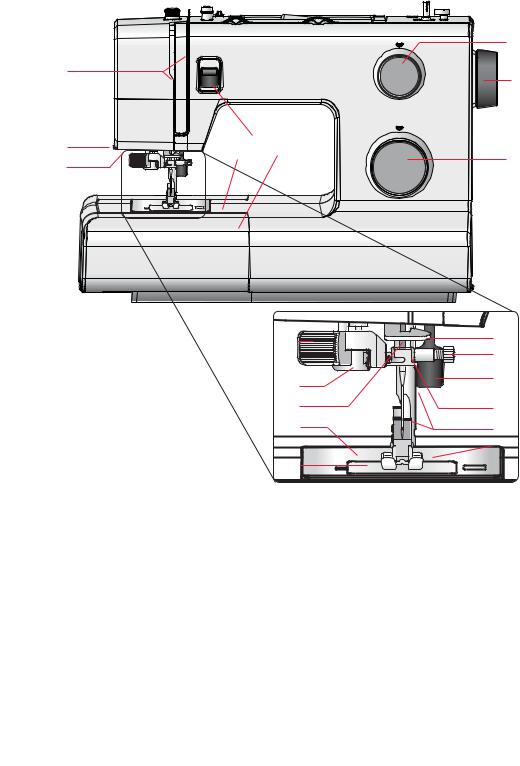
|
7 |
|||
|
1 |
8 |
||
|
2 |
5 |
4 |
6 |
|
3 |
9 |
||
|
10 |
15 |
|
|
16 |
||
|
11 |
17 |
|
|
12 |
18 |
|
|
13 |
19 |
|
|
INTRODUCTION |
20 |
|
|
14 |
||
Présentation de la machine
Face avant
|
)HQWHV G·HQÀODJH |
12. |
Barre à aiguille |
|
|
&RXSH ÀO |
13. |
Plaque à aiguille |
|
|
3. |
Diode DEL |
14. |
Couvercle de canette |
|
4. |
Levier de marche arrière |
*XLGH GH ÀO LQIpULHXU |
|
|
5. |
Bras libre |
16. |
Vis d’aiguille |
|
6. |
Coffret-accessoires |
17. |
Levée du pied-de-biche |
|
7. |
Bouton de longueur de point |
*XLGH ÀO G·DLJXLOOH |
|
|
8. |
Volant |
19. |
Barre à pied-de-biche et support |
|
9. |
Bouton de sélection de point |
de pied-de-biche |
|
|
(QÀOH DLJXLOOH LQWpJUp |
20. |
Pied-de-biche |
|
|
11. |
Levier de boutonnière (150s/160s uniquement) |
6
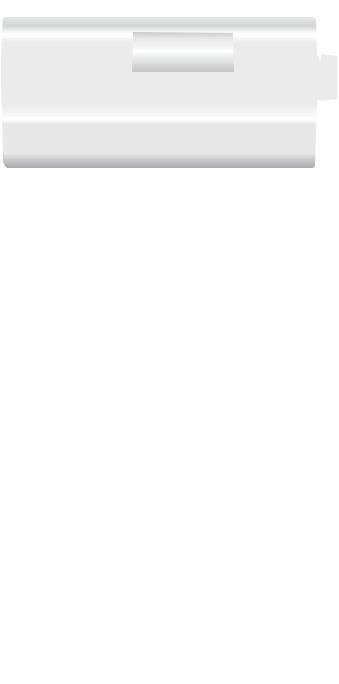
|
Éléments du dessus |
21 |
22 |
23 |
24 |
25 |
||||
|
21. |
Bouton de pression du |
||||||||
|
pied-de-biche |
|||||||||
|
*XLGH ÀOV |
|||||||||
|
23. |
Broches porte-bobine |
||||||||
|
24. |
Trou pour broche porte- |
||||||||
|
bobine repliable |
|||||||||
|
25. Axe du bobineur de canette |
|||||||||
|
5HOHYHXU GH ÀO |
|||||||||
|
‘LVTXHV GH WHQVLRQ GX ÀO |
|||||||||
|
28. |
Disque de tension du bobi- |
||||||||
|
neur de canette |
26 |
27 |
28 |
29 |
30 |
||||
|
%RXWRQ GH WHQVLRQ GX ÀO |
|||||||||
|
30. |
Bouton de largeur de point |
32 |
|||||||
Face arrière
31. Interrupteur principal, branchements du câble d’alimentation et de la pédale de commande
32.Poignée
33.Coulisse pour abaisser les griffes d’entraînement
34. Canettes (3)
35.Rond de feutrine
36.Tournevis
37.Porte-bobine, grand
|
38. |
Porte-bobine, petit |
34 |
35 |
|
39. |
Découvit et brosse (un élément) |
||
|
40. |
Guide-bord |
||
|
41. |
Broche porte-bobine repliable |
37 |
|
|
38 |
|||
Accessoires inclus non illustrés
|
• Pédale et cordon d’alimentation |
40 |
|
|
• |
Aiguilles |
41 |
|
• |
Capot rigide |
7

Pieds-de-biche
Pied-de-biche standard 0
Ce pied est principalement utilisé pour la couture de points droits et de points zigzag, avec une longueur de point supérieure à 1,0 mm.
Clearview Foot 1
Utilisez ce pied pour coudre des points décoratifs, des points zigzag courts et d’autres points utilitaires de moins de 1,0 mm de longueur. La rainure située sous le pied est conçue pour passer sans à-coups au-dessus des points.
Pied pour ourlet invisible 3
Ce pied s’utilise pour les points d’ourlet invisible. L’ergot sur le pied guide le tissu. Le guide rouge sur le pied est conçu pour suivre le bord du pli de l’ourlet.
Remarque : choisissez toujours une largeur de point d’au moins 5 mm lorsque vous utilisez le pied pour ourlet invisible 3. Si vous sélectionnez une largeur de point autre que celle recommandée, déplacez l’aiguille à l’aide du volant pour vous assurer qu’elle ne heurtera pas la pointe métallique du pied.
Pied pour fermeture à glissière 4
Ce pied peut être posé à droite ou à gauche de l’aiguille pour coudre facilement près du bord des dents de la fermeture, des deux côtés. Déplacez la position d’aiguille à droite ou à gauche pour coudre plus près des dents de la fermeture.
Pied pour boutonnière quatre étapes 5A (pour la 130s/140s)
La semelle de ce pied comporte des repères indiquant avec précision où commencer et où arrêter votre boutonnière.
Pied pour boutonnière une étape 5B (pour la 150s/160s)
Ce pied dispose d’un espace à l’arrière où placer un bouton pour
GpÀQLU OD WDLOOH GH OD ERXWRQQLqUH /D PDFKLQH FRXGUD XQH ERXWRQnière qui correspond à cette taille de bouton.
8

Vue d’ensemble des points – 150s/160s
|
Point |
Nom |
Description |
|||||||||
|
5B |
Boutonnière 1 étape |
Boutonnière standard |
|||||||||
|
0 |
Point droit |
Pour toutes les coutures au point droit et la surpi- |
|||||||||
|
qûre |
|||||||||||
|
0 |
Point zigzag |
Pour surjeter et réaliser des appliqués |
|||||||||
|
0 |
Point zigzag triple |
Pour piquer sur des élastiques, repriser les |
|||||||||
|
accrocs et coudre des pièces |
|||||||||||
|
3 |
Point d’ourlet invi- |
Pour la couture d’ourlets invisibles |
|||||||||
|
sible |
|||||||||||
|
3 |
Point d’ourlet |
Pour coudre des ourlets invisibles et surjeter de |
|||||||||
|
invisible élastique * |
manière simultanée, pour les tissus élastiques |
||||||||||
|
également |
|||||||||||
|
1 |
Point décoratif |
Pour tous les tissus et types d’ouvrages |
|||||||||
|
1 |
Point de smock |
Point satin décoratif |
|||||||||
|
1 |
Feston ouvert |
Point satin décoratif |
|||||||||
|
1 |
Point cocotte * |
3RXU OH VXUÀODJH OD FRXWXUH G·pODVWLTXH OH |
|||||||||
|
reprisage des accrocs et l’insertion de pièces |
|||||||||||
|
0/1 |
Point fantaisie |
Un point décoratif traditionnel, par exemple pour |
|||||||||
|
les bordures et les serviettes |
|||||||||||
|
0/1 |
Point fantaisie |
3RXU OHV RXUOHWV GpFRUDWLIV VXU OHV WLVVXV ÀQV SDU |
|||||||||
|
exemple le lin |
|||||||||||
|
0 |
Point droit renforcé |
Pour les coutures extensibles, par exemple les |
|||||||||
|
* |
coutures d’entrejambe sur les vêtements de sport |
||||||||||
|
ou de travail |
|||||||||||
|
1 |
Point zigzag ren- |
Pour coudre un élastique sur du tissu extensible |
|||||||||
|
forcé * |
|||||||||||
|
1 |
Point nid d’abeille * |
3RXU FRXGUH VXU GHV ÀOV pODVWLTXHV HW IDLUH GHV |
|||||||||
|
coutures d’ourlet décoratives |
|||||||||||
|
1 |
Point de bord étroit |
Un point décoratif |
|||||||||
|
* |
|||||||||||
|
3 |
Superstretch * |
Un point décoratif extensible |
|||||||||
|
1 |
Point décoratif |
Un point décoratif |
|||||||||
|
1 |
Points de croix |
Un point décoratif |
|||||||||
|
1 |
Point décoratif |
Un point décoratif |
|||||||||
|
0 |
Point d’épine |
Un point décoratif |
|||||||||
|
3 |
Point overlock |
Une couture surjetée fermée pour les tissus |
|||||||||
|
fermé * |
V·HIÀORFKDQW |
||||||||||
|
3 |
Point overlock * |
Une couture surjetée fermée pour les tissus |
|||||||||
|
UpVLVWDQWV RX QH V·HIÀORFKDQW SDV |
|||||||||||
|
* Ces points sont des points extensibles |
9 |
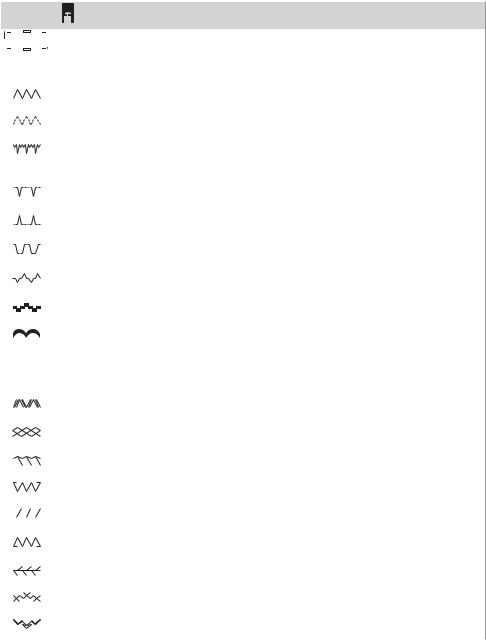
Vue d’ensemble des points – 130s/140s
|
Point |
Nom |
Description |
|||||||||||||||
|
1 |
2 |
4 |
3 |
5A |
Boutonnière 4 étapes |
Boutonnière standard |
|||||||||||
|
0 |
Point droit |
Pour toutes les coutures au point droit et la |
|||||||||||||||
|
surpiqûre |
|||||||||||||||||
|
0 |
Point zigzag |
Pour surjeter et réaliser des appliqués |
|||||||||||||||
|
0 |
Point zigzag triple* |
Pour piquer sur des élastiques, repriser les accrocs |
|||||||||||||||
|
et coudre des pièces |
|||||||||||||||||
|
3 |
Point d’ourlet |
Pour coudre des ourlets invisibles et surjeter de |
|||||||||||||||
|
invisible élastique * |
manière simultanée, pour les tissus élastiques |
||||||||||||||||
|
également |
|||||||||||||||||
|
3 |
Point d’ourlet |
Pour la couture d’ourlets invisibles |
|||||||||||||||
|
invisible |
|||||||||||||||||
|
0/1 |
Point fantaisie |
3RXU OHV RXUOHWV GpFRUDWLIV VXU OHV WLVVXV ÀQV SDU |
|||||||||||||||
|
exemple le lin |
|||||||||||||||||
|
0/1 |
Point fantaisie |
Un point décoratif traditionnel, par exemple pour |
|||||||||||||||
|
les bordures et les serviettes |
|||||||||||||||||
|
1 |
Point cocotte * |
3RXU OH VXUÀODJH OD FRXWXUH G·pODVWLTXH OH UHSULVDJH |
|||||||||||||||
|
des accrocs et l’insertion de pièces |
|||||||||||||||||
|
1 |
Point de smock |
Point satin décoratif |
|||||||||||||||
|
1 |
Feston ouvert |
Point satin décoratif |
|||||||||||||||
|
0 |
Point droit renforcé * |
Pour les coutures extensibles, par exemple les cou- |
|||||||||||||||
|
tures d’entrejambe sur les vêtements de sport ou de |
|||||||||||||||||
|
travail |
|||||||||||||||||
|
1 |
Point zigzag renforcé |
Pour coudre un élastique sur du tissu extensible |
|||||||||||||||
|
* |
|||||||||||||||||
|
1 |
Point nid d’abeille * |
3RXU FRXGUH VXU GHV ÀOV pODVWLTXHV HW IDLUH GHV FRX- |
|||||||||||||||
|
tures d’ourlet décoratives |
|||||||||||||||||
|
3 |
Super extensible * |
Un point décoratif extensible |
|||||||||||||||
|
1 |
Point de bord étroit |
Un point décoratif |
|||||||||||||||
|
3 |
Point overlock * |
Une couture surjetée fermée pour les tissus résis- |
|||||||||||||||
|
WDQWV RX QH V·HIÀORFKDQW SDV |
|||||||||||||||||
|
3 |
Point overlock fermé * |
Une couture surjetée fermée pour les tissus |
|||||||||||||||
|
V·HIÀORFKDQW |
|||||||||||||||||
|
0 |
Point d’épine |
Un point décoratif |
|||||||||||||||
|
1 |
Points de croix |
Un point décoratif |
|||||||||||||||
|
1 |
Point décoratif |
Un point décoratif |
|||||||||||||||
* Ces points sont des points extensibles
10

PRÉPARATIONS
Déballage
1.Placez la boîte sur une surface plate et rigide. Sortez la machine de la boîte, retirez l’emballage externe et sortez la mallette de la machine.
2.Retirez tous les matériaux d’emballage externes et le sac en plastique.
Remarque : votre machine à coudre SMARTER BY PFAFF™ 130s/140s/150s/160s est réglée pour vous donner la meilleure qualité de point à une température ambiante normale. Les températures extrêmement élevées ou basses peuvent affecter les résultats de couture.
Branchement de l’alimentation électrique
Parmi les accessoires, vous trouverez la prise d’alimentation et la pédale de commande.
Remarque : consultez un électricien qualifié en cas de doute sur la connexion de la machine à la source d’alimentation. Débranchez le cordon d’alimentation lorsque la machine n’est pas utilisée.
Pour cette machine à coudre, le modèle de pédale de commande FC-1902 (110-120V), FC-2902A/FC-2902D (220-240V) fabriqué par ZHEJIANG FOUNDER MOTOR CORPORATION LTD (China) doit être utilisé.
1.Branchez la pédale dans la prise (A) de la machine à coudre et dans la prise murale. La vitesse de couture se régule en appuyant sur la pédale.
2.Mettez l’interrupteur O/I (B) sur « I » pour allumer l’alimentation et l’éclairage.
B

Pour les États-Unis et le Canada
Cette machine à coudre est équipée d’une prise
SRODULVpH j VHQV XQLTXH XQH ÀFKH HVW SOXV ODUJH TXH O·DXWUH $ÀQ GH UpGXLUH OH ULVTXH G·pOHFWURFXWLRQ FHWWH ÀFKH HVW GHVWLQpH j rWUH EUDQFKpH GDQV
XQH SULVH SRODULVpH j VHQV XQLTXH 6L OHV ÀFKHV QH rentrent pas totalement dans la prise, retournezles. Si la prise ne rentre toujours pas, contactez un
pOHFWULFLHQ TXDOLÀp SRXU TX·LO LQVWDOOH XQH SULVH DGpTXDWH 7RXWH PRGLÀFDWLRQ GH OD SULVH HVW j SURVFULUH
11

Смотреть руководство для Pfaff Smarter 130S ниже. Все руководства на ManualsCat.com могут просматриваться абсолютно бесплатно. Нажав кнопку «Выбор языка» вы можете изменить язык руководства, которое хотите просмотреть.
MANUALSCAT | RU
Вопросы и ответы
У вас есть вопрос о Pfaff Smarter 130S, но вы не можете найти ответ в пользовательском руководстве? Возможно, пользователи ManualsCat.com смогут помочь вам и ответят на ваш вопрос. Заполните форму ниже — и ваш вопрос будет отображаться под руководством для Pfaff Smarter 130S. Пожалуйста, убедитесь, что вы опишите свои трудности с Pfaff Smarter 130S как можно более детально. Чем более детальным является ваш вопрос, тем более высоки шансы, что другой пользователь быстро ответит на него. Вам будет автоматически отправлено электронное письмо, чтобы проинформировать вас, когда кто-то из пользователей ответит на ваш вопрос.
Задать вопрос о Pfaff Smarter 130S
- Бренд:
- Pfaff
- Продукт:
- швейные машины
- Модель/название:
- Smarter 130S
- Тип файла:
- Доступные языки:
- английский
Сопутствующие товары Pfaff Smarter 130S
Производитель: Pfaff
Электромеханическая швейная машина Пфафф Смартер 130s
Pfaff Smarter 130s отличается интересным ярким дизайном, имеет 21 швейную операцию, включая полуавтоматическую петлю, в ней есть только все самое необходимое для занятия любимым хобби. Однако, машина прекрасно справляется со своей задачей и отличается немецким качеством, проверенным временем. Эта модель станет вам отличным помощником, если вы только решили начать заниматься шитьем и делаете свои первые шаги в этом увлекательном виде рукоделия.
Особенности:
Нитевдеватель
Встроенный заправщик нити облегчит вам трудоемкий процесс. Просто возьмитесь за кончик нити, а заправщик сам протянет ее через ушко иглы.
Изменение ширины строчки
Установите необходимую ширину стежка. Функция изменения его ширины особенно полезна при отстрочке по верху ткани и для других операций, требующих точное позиционирование иглы.
Лапки Pfaff
У вас есть возможность использовать множество дополнительных лапок PFAFF® для выполнения специальных швейных операций.
Светодиодная подсветка
Светодиодные элементы подсветки очень долговечны и прекрасно освещают рабочее пространство.
Жесткий чехол
Все модели SMARTER BY PFAFF™ комплектуются жесткими футлярами для их безопасной переноски.
Инструкции для Pfaff Smarter 130s:
Инструкция по эксплуатации Pfaff Smarter 130s (PDF, 16MB, рус)
Характеристики Pfaff Smarter 130s:
- Диапазон прошиваемых материалов
- Очень легкие – 4
Легкие – 5
Средние и умеренно тяжелые – 5
Тяжелые – 4
Трикотаж – 3 - Тип челнока
- Горизонтальный вращающийся челнок
- Максимальная ширина строчки
- 6 мм
- Максимальная длина стежка
- 4 мм
- Количество строчек
- 21
- Режим вымётывания петли
- Полуавтоматическое выметывание бельевой петли за 4 переключения без поворота ткани
- Верхний транспортёр
- нет
- Длина платформы
- 16 см
- Размеры рукавной платформы (длина/обхват)
- 7,5/27,5 см
- Ширина гребёнки транспортера
- 16 мм
- Высота подъема лапки (нормальная/максимальная)
- 6/9
- Электронный стабилизатор усилия прокола
- нет
- Регулятор (ограничитель) максимальной скорости
- нет
- Программируемая остановка иглы в верхнем/нижнем положении
- нет
- Нитевдеватель
- есть
- Горизонтальное расположение катушки
- есть
- Регулятор давления лапки
- есть
- Потребляемая мощность
- 70 Вт
- Тип освещения
- Светодиодное
- Органайзер
- нет
- Автостоп при намотке нитки на шпульку
- есть
- Линейка на корпусе
- нет
- Чехол
- Жесткий
- Швейный советник
- нет
- Стандарт игл
- 130/705H
- Страна разработки
- Германия
- Страна производства
- Китай
- Гарантия
- 3 года
- Вес без упаковки
- 6,2 кг
- Вес с упаковкой
- 8,9 кг
Строчки Pfaff Smarter 130s:
Комплектация
- Педаль
- Жесткий чехол
- Стандартная лапка A
- Лапка для вшивания молнии E
- Лапка для невидимой подрубки G
- Лапка для петли B
- Лапка прозрачная
- Иглы
- Кисточка
- Мягкая подкладка
- Направитель
- Распарыватель
- Отвертка
- Пластина для катушки (большая, маленькая)
- Фиксатор катушки
- Шпульки
Популярные аксессуары для Pfaff Smarter 130s
Наличие:
есть
Наличие:
есть
Наличие:
есть
Товары похожие на Pfaff Smarter 130s
Обратите внимание!
«Швейный Мир» является официальным дистрибьютором швейных машин фирмы Pfaff. Покупая Pfaff в наших магазинах, Вы получите качественную машину, обеспеченную гарантийным и сервисным обслуживанием.
Опубликуйте ваш отзыв
Отзывы о товаре могут оставлять только зарегистрированные покупатели.












